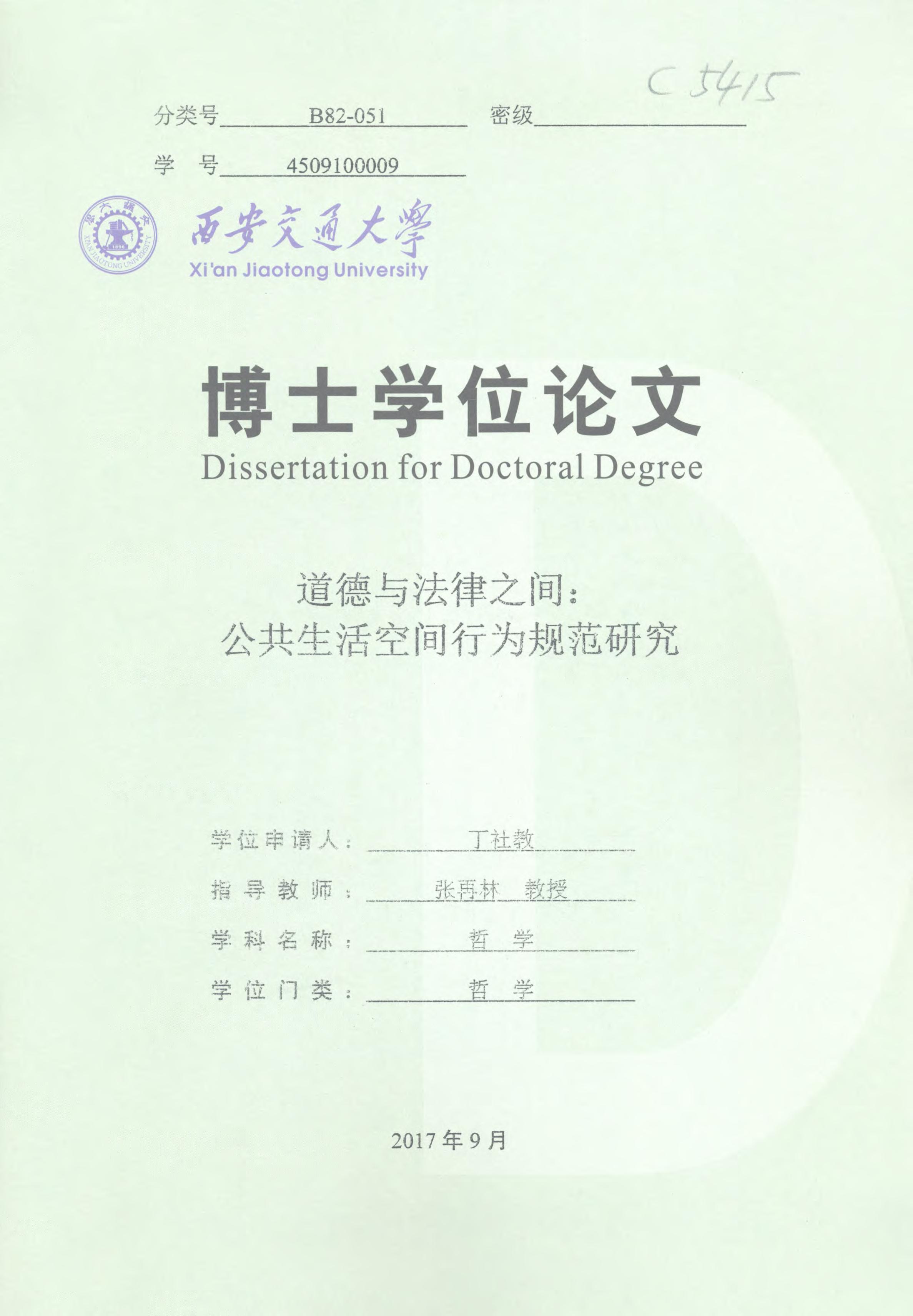
随着社会的变迁和发展,旧的行为规范不断遭遇挑战,而与发展状况相适应的行为规范尚未完全建立起来,公共生活空间行为失范现象时常发生,因此,尽快重构中国公共生活空间行为规范就成为当务之急。 这是一个十分复杂的问题束,本文以道德失灵和法律失灵作为切入点,以公共生活空间行为规范解构与重构作为主要研究内容,以唯物史观为基础,借助社群主义理论、规训理论、社会分工理论、交往行为理论和家本伦理理论等理论方法展开研究。 本文首先对治理公共生活空间行为失范法治化困境的理论根源进行了分析。目前法治化的困境表现为:人们自觉遵法守法的法治意识还不强,而依靠道德教育,提高民众的道德自律能力,这一努力的成效难以显见。事实上,在大多数情况下,人们调节人际关系、处理各种人际冲突并不诉诸于法律制约,也难以直接诉诸个人的道德素养。由于群体对个人从来都是一个巨大的不可随意选择的存在,作为自律性规范的道德与作为他律性强制性规范的法律,并未全部涵盖人们的行为规范。由此得出的结论是,道德与法律作为两种有着相对明确界限的行为规范之间,一直运行着弥散在人与人互动行为中的公共生活空间行为规范——伦理(或伦常),这应该成为解决公共地问题的历史和逻辑起点。 论文继而对公共生活空间行为规范的构成、特点进行了较为系统的分析,认为政治学意义的公共领域抑或物理意义的交往场所都属于公共生活空间。两个人抑或许多人的公共生活必然都是具有相对公共性的生活,其自身与他人的和谐相处是需要行为规范又存在行为规范的。这种行为规范功能的实现离不开公共场所如家庭和学校等物理空间、公共权威、公共活动与事件、公共资源、主体身份等五个要素,这五个因素相互作用构成了动态的公共生活空间行为规范。而元规范、进出门槛、组织化、身份可见性和主体的自我身份认同构成了公共生活空间行为规范约束力的前提条件,这五个条件功能不同又互补,共同决定了公共生活空间行为规范约束力的有效与否和强弱。 论文进一步分析了公共生活空间行为规范失范的原因及其建构的可能性。认为,公共生活空间行为规范的失范、生成或建构、解构和重构是一个自然的历史过程,是公共生活空间要素及其结构的客观性和行为主体的主观能动性相统一的矛盾演化发展过程。由于中国的社会分工发生着结构性变化,各种类型的公共生活空间结构正在进行着解构与重构,家庭、学校和单位社区的结构与功能出现重大变化,原有的公共生活空间行为规范已经失去了约束力。同时,新事物网络媒体迅猛成长,并产生了结构发展和功能统合趋势,而公共部门对于公共生活空间行为规范的建构和治理功能不断凸显。所以,建构公共生活空间行为规范应该从现实的生活世界出发,致力于推进家庭、学校尤其是公共部门成员的主体认同和主体性建构。 关键词:道德 法律 公共生活空间 公共生活空间行为规范 论文类型:理论研究
With the social development and changes, the old code of conduct constantly run up against the challenges, and the code of conduct that compatible with the development situation has not yet been fully established, while the behavior anomie phenomenon often occurred in the public living space, therefore, it is urgent to reconstruct the behavior norms of public living space in China. This is a very complicated problem domain, so this paper takes moral failure and legal failure as the starting point, also takes the deconstruction and reconstruction of the public living space behavior norms as the main research contents, the paper carried on research, which based on historical materialism, with the help of the communitarianismtheory, discipline theory, the theory of social division of labor, the theory of communicative action and family-based ethics theoretical method. This paper first analyzes the theoretical roots of the legalizationdilemma in governing the behavior anomie of public living space. At present, the legalizationdilemma is manifested as: people's legalization consciousness in abide by the law consciously is not strong. However, it is also hard to see how this effort can achieve by relying on ethics education to improve people's moral self-discipline. In fact, in most cases, people are not resorting to legal restraints on interpersonal relations and dealing with interpersonal conflicts, and it is also difficult to appeal directly to individual moral attainments. Due to the group has always been a huge and not arbitrary choice for the individual, therefore, the moral as a self-discipline norm and the law as a mandatory norm of heteronomy, both of them are not fully cover the norms of human behavior. Thus the conclusion is that,Morality and law are two codes of conduct with relatively clear boundary,but between them, there has been running a norm of public living space behavior ethic or social conventions, which diffuse in human interactive behavior.This should be the historical and logical starting point of solving the "tragedy of the commons" problems. This paper then makes a relativelysystematic analysis of the constitution and characteristics of the public living space behavior norms, it is considering that, both the public sphere of political significance and the place of communication in the physical sense belong to the public living space. The public life of two people or many people are inevitable with a relatively public life, and the harmony of its own and others is needed to behavior norms and existed behavior norms. The realization of the function of the behavior standards cannot do without public places such as families and schools and other physical spaces, public authority, public activities and events, public resources andsubject identity. These five factors interact to form a dynamic public living space behavior norms. Meta-norms, threshold of entry and exit, organization, the visibility of identity, and subjective self-identityconstitute the prerequisite for the constraints of public living space behavior norms. These five factors have different functions and complement each other, which determine the effectiveness and strength of the constraints of public living space behavior norms. The paper further analyzes the causes of the behavior anomie of public living space and the possibility of its construction. It is believed that the anomie, formation or construction, deconstruction and reconstruction of the behavior norms of public living space are a natural historical process, it is the contradictory evolution and development process that the objectivity of the elements and structure of public living space unified with the subjective initiative of the behavior subject. Due to China's social division of labor undergoing structural changes, and various types of structure of public living space is undergoing deconstruction and reconstruction.the construction and function of family, school and community are also change significantly, the original behavior norms of public living has lost its binding force. At the same time, the new internet media has been growing rapidly and has produced a trend of structural development and unified function. The public sector has become more and more prominent in the aspect of the construction and governance of public living space behavior norms. Therefore, the constructionof public living space behavior norms should set out from the real life world, is committed to promote the subject identity and subjective construction of the members of family, school especially the public sector members. KEY WORDS: Morality; Law; Public living space; Behavior norms of public living space TYPE OF DISSERTATION: Theoretical Research